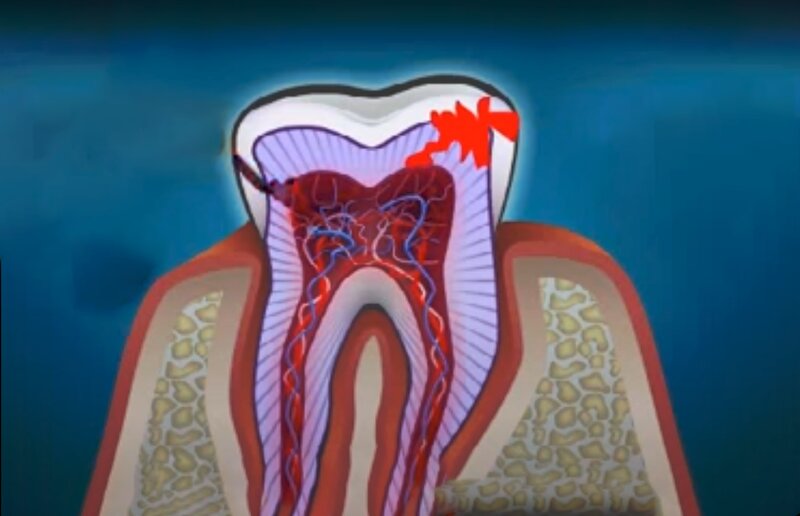If a Cavity Hurts, is it too Late to Save the Tooth? What are the different stages of cavities? How to avoid dental cavities? what to do to save a decayed tooth? If a cavity hurts too much, is it too late for brushing to save it?
Let’s answer all these questions!
I. What is a cavity?
A tooth cavity is a lesion on the surface or enamel of a tooth. It occurs when bacteria in the mouth produce acid, which damages the enamel.
Cavities are small holes in the teeth. They can cause discomfort, infection, and sometimes tooth loss if left untreated.
II. If a Cavity Hurts, is it Too Late to Save the Tooth?
Cavities are often not painful when they first appear, so people often delay getting them treated, either out of laziness or fear of the dentist.
However, you should know that leaving a cavity untreated can lead to the loss of the affected tooth.
The first option for treating a cavity is to get a filling.
The dentist cleans the tooth tissue, removes the infection, and replaces the cavity with a biocompatible sealant during restorative therapy.
If you have ignored a cavity and it has started to hurt a lot, it means that the infection has progressed to affect the nerves in the tooth.
Because these tissues are involved in receiving external stimuli such as heat or cold and transmitting signals to our brain, they will generate significant pain if they are injured, either by a cavity or by trauma.
A root canal treatment will be necessary for this situation. And this procedure is performed by the dentist to remove the bacteria and the tissues they have damaged while completely cleaning the dental canals.
The dentist will perform this procedure under local anesthesia to ensure that you have as little discomfort as possible.
And after that, he will close the canals and put a dental crown to protect the inside of the tooth and allow you to have a nice tooth.
III. What are the different stages of cavities?
Dental plaque is a whitish, sticky film that covers the surface of teeth when they are not cleaned regularly.
It is made up of microorganisms, food particles, and saliva.
This plaque is the main cause of dental cavities. We can reasonably divide its progression into five phases. Let’s take a look at these five stages of tooth decay together:
Stage 1: white spots
Despite its appearance of fragility, the enamel that covers the teeth is one of the most resistant elements of the human body.
It is made up mostly of minerals. When a tooth is exposed to the acids created by the bacteria in plaque, the enamel begins to erode.
If this happens, you may see a white spot on one of your teeth. This area of mineral loss is a precursor to tooth decay.
Stage 2: Enamel deterioration
Tooth enamel continues to deteriorate as the decay process progresses.
A white spot on a tooth can deepen and turn brown over time. Small cavities, called cavities, can develop in your teeth if your tooth enamel continues to be attacked by acid produced by bacteria.
To stop the progression of a cavity, your dentist must fill the cavity and maintain impeccable dental hygiene.
Stage 3: Caries reaches the dentin
Dentin is the tissue beneath the enamel. It is softer than enamel, which makes it more vulnerable to acid damage. And tooth deterioration is greatly accelerated at this stage.
Teeth can become sensitive to hot or cold meals or drinks when dentin is affected by tooth decay.
Stage 4: Infection of the dental pulp
The pulp (dental pulp) is the deepest layer of the tooth. It contains nerves and blood vessels that contribute to the health of the tooth.
The nerves in the pulp also allow the tooth to feel pain.
The pulp of the tooth can become inflamed and swollen if it is injured.
Because the tissues surrounding the tooth are unable to grow to accommodate the swelling, pressure can be placed on the nerves. This can cause discomfort and pain.
Stage 5: Dental abscess
When tooth decay penetrates the pulp, bacteria can enter and cause an infection.
This infection can progress to inflammation, which in most cases leads to the creation of a pus pocket under the tooth, called an abscess.
Dental abscesses can cause excruciating pain that radiates into the jaw.
Other symptoms may include swelling of the gums, cheeks, or jaw, fever, and enlarged lymph nodes in the neck.
A dental abscess must be treated immediately because the infection can spread to the jawbone and other parts of the head and neck.
In many circumstances, treatment may be as simple as removing the affected tooth.

IV. How to avoid dental cavities?
1. Regular brushing
The best way to avoid tooth decay is still to take care of your oral hygiene. To do this, brush your teeth regularly.
If possible, do it after every meal. If not, do it at least twice a day; in the morning and before bed.
2. Rinse your mouth
Rinsing your mouth will further remove bacteria in your mouth.
Don’t hesitate to turn to a natural rinsing method like oil mouthwash.
You can use coconut or virgin olive oil instead of traditional mouthwash.
3. Avoid sugar consumption
Sugar is the most implicated food in the development of tooth decay. Avoid sugar consumption as much as you can, which means eating candy, soda, sweets, and the like.
If you have trouble, be sure to clean your teeth afterwards, and especially never consume sugar before bed.
4. Floss regularly
Flossing helps you to clean your teeth well. It is very useful to remove the remains of food stuck between the teeth.
Flossing also reduces the risk of getting interdental cavities.
5. Regular visits to the dentist
To maintain good dental hygiene, you should visit your dentist regularly.
Visit your dentist at least once a year for a check-up and professional scaling.
6. Phytic acid reduction
Phytic acid is found in grains, nuts, or legumes. It is present in whole grains and prevents the full absorption of the minerals present in these foods.
The lack of minerals is often pointed out as a cause of tooth decay.
V. Other questions about A hurting cavity
1. When Is It Too Late for A Cavity with Pain?
It is never too late for dental treatment of a cavity, except in the last case where the pulp is very extensively attacked by bacteria.
Otherwise, cavities can be treated, as discussed above, with a good filling for the early stages and a root canal for the intermediate stages where the pulp is not completely lost.
Tooth extraction may be the only option if a tooth cannot be restored with a crown or dental filling due to accidental damage or extensive decay.
2. If a cavity hurts too much, is it too late for brushing to save it?
Once the cavity has reached the dentin, it is almost impossible to recover the tooth by brushing it regularly.
It is true that brushing can delay the progression of tooth decay, but unfortunately cannot stop it permanently.
3. When is it too late to fill a cavity?
A cavity is a destruction of the enamel and teeth resulting from an imbalance of bacteria naturally present in the mouth.
When it hurts, in many cases it is almost too late for a filling. It is possible that the decay has reached the pulp and severely damaged it.
But sometimes, when the pulp is only slightly damaged, the dentist can apply a temporary material until the pulp heals. Only then can a restorative filling be applied to the tooth!
4. if a cavity hurts does that mean a root canal?
Yes, in most cases. When you feel a lot of pain, it means that the decay has reached the pulp and if the pulp is largely affected, all that remains is to perform a root canal and then put a crown to protect the inside of the tooth that has been well cleaned.
5. how long can you leave a cavity untreated
Cavities, as we have seen throughout this article, occur when bacteria in the mouth secrete an acid that attacks the tooth enamel, causing a small hole.
If left untreated, cavities can become larger and more painful, leading to more serious dental problems.
Therefore, it is important not to leave a cavity untreated for an extended period of time.
On average, it takes 6 months to go from a stage 1 cavity to a stage 3 cavity, which is why it’s important to see a dentist twice a year for an overall check-up of your dental health.
It takes an average of 6 months to go from a stage 1 cavity to a stage 3, which is why it is important to see a dentist twice a year for an overall check-up of your dental health.
In conclusion, for a person who takes care of his teeth, a period of 6 months is the maximum he can wait to treat the beginning of a dental cavity.
Otherwise, for those who are less concerned about their dental hygiene, it is strongly advised to consult a dentist as soon as possible.
6. Can I wait 6 months to fill a cavity
The answer is both yes and no.
For whatever reason, a person who is concerned about his dental hygiene can stop the progression of tooth decay if he brushes regularly after every meal and avoids all foods that can promote the growth of bacteria in the mouth, such as sugar and various sweets.
But you should know that this is a difficult task.
Because, in most cases, 6 months is more than enough time for a superficial cavity to reach the dentin and sometimes the pulp, especially if the person in question is not very regular in brushing and cleaning the mouth.
In conclusion, go see a dentist as soon as possible if you suspect the beginning of tooth decay.
7. can a badly decayed tooth be saved
Unfortunately, there comes a time when a tooth that has been severely affected by tooth decay cannot be saved. In such a situation, extraction is the only possible solution.
However, only the dentist, after a thorough examination, will be able to tell whether or not a decayed tooth can be saved.
8. Can coconut oil reverse cavities
The Athlone Institute of Technology (AIT) in Ireland recently discovered that coconut oil can effectively prevent the growth of harmful oral bacteria.
This study showed that using coconut oil can significantly reduce the risk of oral infections, cavities, and Candida Albicans.
If we understand the study correctly, this natural oil can prevent oral infections and cavities, but not cure them permanently, which is a kind of regeneration of enamel.
The answer to the question is that coconut oil can prevent cavities but not cure them.
Therefore, it is wise to consider using coconut oil for better oral health.
9. How do I know if I have a root canal or a cavity?
The root canal is the inside of the tooth root filled with tooth tissue.
Inside Healthy teeth are filled with pulp.
In the area of the root tip of the tooth, the root canal is often crossed by strong branches and ramifications.
Tooth decay, on the other hand, is a dental disease, a process in which plaque builds up on the surface of the teeth and gradually makes a hole until it reaches the root canal.
If a tooth is very deeply damaged by decay, a root canal is often necessary. The dentist cleans and fills the finely branched canals.
In the case of a small hole in the tooth, a simple filling is enough to save the tooth.
Only your dentist, after an examination of your teeth, can advise you on the best method to save your tooth.

